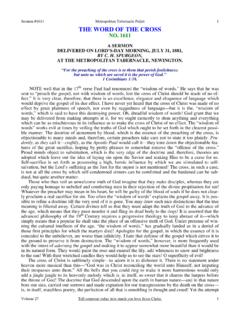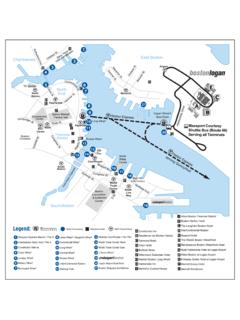Transcription of Realtime Multi-Person 2D Pose Estimation using Part ...
1 Realtime Multi-Person 2D pose Estimation using part Affinity Fields Zhe CaoTomas SimonShih-En WeiYaser SheikhThe Robotics Institute, Carnegie Mellon present an approach to efficiently detect the 2D poseof multiple people in an image. The approach uses a non-parametric representation, which we refer to as part AffinityFields (PAFs), to learn to associate body parts with individ-uals in the image. The architecture encodes global con-text, allowing a greedy bottom-up parsing step that main-tains high accuracy while achieving Realtime performance,irrespective of the number of people in the image.
2 The ar-chitecture is designed to jointly learn part locations andtheir association via two branches of the same sequentialprediction process. Our method placed first in the inaugu-ral COCO 2016 keypoints challenge, and significantly ex-ceeds the previous state-of-the-art result on the MPII Multi-Person benchmark, both in performance and IntroductionHuman 2D pose Estimation the problem of localizinganatomical keypoints or parts has largely focused onfinding body parts ofindividuals[8, 4, 3, 21, 33, 13, 25, 31,6, 24]. Inferring the pose of multiple people in images, es-pecially socially engaged individuals, presents a unique setof challenges.
3 First, each image may contain an unknownnumber of people that can occur at any position or , interactions between people induce complex spa-tial interference, due to contact, occlusion, and limb articu-lations, making association of parts difficult. Third, runtimecomplexity tends to grow with the number of people in theimage, making Realtime performance a common approach [23, 9, 27, 12, 19] is to employa person detector and perform single-person pose estima-tion for each detection. These top-down approaches di-rectly leverage existing techniques for single-person poseestimation [17, 31, 18, 28, 29, 7, 30, 5, 6, 20], but sufferfrom early commitment: if the person detector fails as itis prone to do when people are in close proximity there isno recourse to recovery.
4 Furthermore, the runtime of these Video result: : Multi-Person pose Estimation . Body parts belong-ing to the same person are left: part Affinity Fields(PAFs) corresponding to the limb connecting right elbow and rightwrist. The color encodes right:A zoomed inview of the predicted PAFs. At each pixel in the field , a 2D vectorencodes the position and orientation of the approaches is proportional to the number of peo-ple: for each detection, a single-person pose estimator isrun, and the more people there are, the greater the computa-tional cost. In contrast, bottom-up approaches are attractiveas they offer robustness to early commitment and have thepotential to decouple runtime complexity from the numberof people in the image.
5 Yet, bottom-up approaches do notdirectly use global contextual cues from other body partsand other people. In practice, previous bottom-up meth-ods [22, 11] do not retain the gains in efficiency as the fi-nal parse requires costly global inference. For example, theseminal work of Pishchulin et al. [22] proposed a bottom-upapproach that jointly labeled part detection candidates andassociated them to individual people. However, solving theinteger linear programming problem over a fully connectedgraph is an NP-hard problem and the average processingtime is on the order of hours.
6 Insafutdinov et al. [11] builton [22] with stronger part detectors based on ResNet [10]and image-dependent pairwise scores, and vastly improvedthe runtime, but the method still takes several minutes perimage, with a limit on the number of part proposals. Thepairwise representations used in [11], are difficult to regressprecisely and thus a separate logistic regression is [ ] 14 Apr 2017(b) part Confidence Maps(c) part Affinity Fields(a) Input Image(d) Bipartite Matching(e) Parsing ResultsFigure 2. Overall pipeline. Our method takes the entire image as the input for a two-branch CNN to jointly predict confidence maps forbody part detection, shown in (b), and part affinity fields for parts association, shown in (c).
7 The parsing step performs a set of bipartitematchings to associate body parts candidates (d). We finally assemble them into full body poses for all people in the image (e).In this paper, we present an efficient method for Multi-Person pose Estimation with state-of-the-art accuracy onmultiple public benchmarks. We present the first bottom-uprepresentation of association scores via part Affinity Fields(PAFs), a set of 2D vector fields that encode the locationand orientation of limbs over the image domain. We demon-strate that simultaneously inferring these bottom-up repre-sentations of detection and association encode global con-text sufficiently well to allow a greedy parse to achievehigh-quality results, at a fraction of the computational have publically released the code for full reproducibil-ity, presenting the first Realtime system for Multi-Person 2 Dpose MethodFig.
8 2 illustrates the overall pipeline of our method. Thesystem takes, as input, a color image of sizew h(Fig. 2a)and produces, as output, the 2D locations of anatomical key-points for each person in the image (Fig. 2e). First, a feed-forward network simultaneously predicts a set of 2D con-fidence mapsSof body part locations (Fig. 2b) and a setof 2D vector fieldsLof part affinities, which encode thedegree of association between parts (Fig. 2c). The setS=(S1,S2,..,SJ)hasJconfidence maps, one per part , whereSj Rw h,j { }. The setL= (L1,L2,..,LC)hasCvector fields, one per limb1, whereLc Rw h 2,c { }, each image location inLcencodes a 2D vec-tor (as shown in Fig.)
9 1). Finally, the confidence maps andthe affinity fields are parsed by greedy inference (Fig. 2d)to output the 2D keypoints for all people in the Simultaneous Detection and AssociationOur architecture, shown in Fig. 3, simultaneously pre-dicts detection confidence maps and affinity fields that en-code part -to- part association. The network is split into twobranches: the top branch, shown in beige, predicts the con-fidence maps, and the bottom branch, shown in blue, pre-dicts the affinity fields. Each branch is an iterative predic-1We refer to part pairs as limbs for clarity, despite the fact that somepairs are not human limbs ( , the face).
10 H0 w03 3C3 3C1 1C1 1Ch0 w0 Stage 1 Staget,(t 2)Branch 1 Branch 13 3C3 3C3 3C3 3CL1 StLt1 1C1 1C7 7C7 7C7 7C7 7C7 7C1 1C1 1C7 7C7 7C7 7C7 7C7 7C3 3C3 3C3 3C1 1C1 t 1 1 tBranch2 Branch 1 InputImage1 1C1 1Ch w 3h0 w0h0 w0 LossLossLossConvolutionf11 Lossf12ft2ft1 Branch2S1 Figure 3. Architecture of the two-branch multi-stage CNN. Eachstage in the first branch predicts confidence mapsSt, and eachstage in the second branch predicts PAFsLt. After each stage, thepredictions from the two branches, along with the image features,are concatenated for next architecture, following Wei et al.
![arXiv:0706.3639v1 [cs.AI] 25 Jun 2007](/cache/preview/4/1/3/9/3/1/4/b/thumb-4139314b93ef86b7b4c2d05ebcc88e46.jpg)

![arXiv:1301.3781v3 [cs.CL] 7 Sep 2013](/cache/preview/4/d/5/0/4/3/4/0/thumb-4d504340120163c0bdf3f4678d8d217f.jpg)
![@google.com arXiv:1609.03499v2 [cs.SD] 19 Sep 2016](/cache/preview/c/3/4/9/4/6/9/b/thumb-c349469b499107d21e221f2ac908f8b2.jpg)












